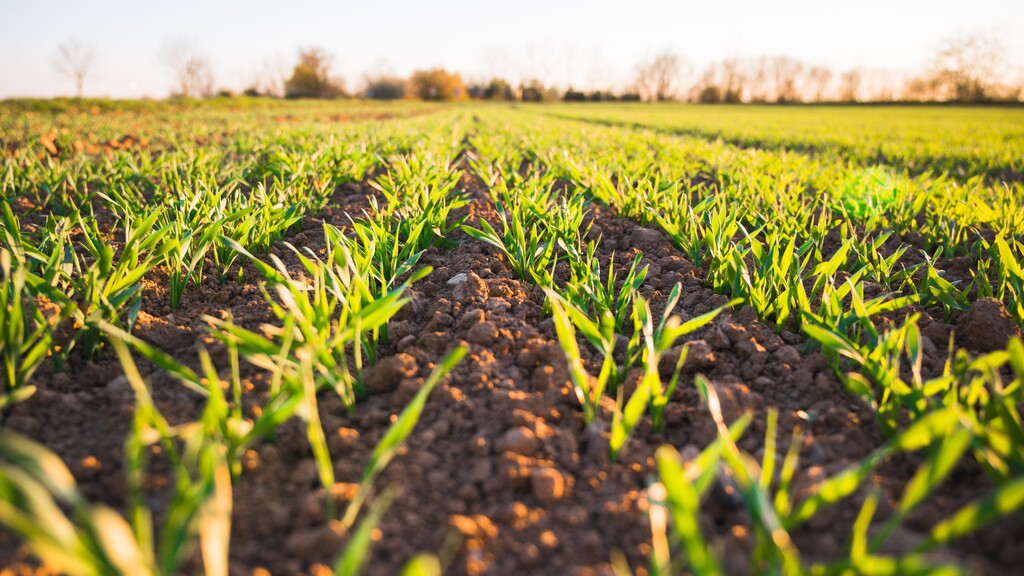

Herbizide mit dem Wirkstoff Glyphosat haben einen deutlichen Effekt auf die Bodenorganismen – Diese Erkenntnis stammt aus einer Studie, die die Auswirkungen von Herbiziden auf Regenwürmer und Mykorrhiza-Pilze untersucht. Die Studie zeigt: Regenwürmer, die dem Herbizid ausgesetzt sind, werden dicker und sind weniger aktiv. Zeitgleich halbiert sich die Mykorrhizierung von Pflanzenwurzeln und dem Boden. 3
Die Studie untersucht auch die Vermehrung der Würmer. Das Ergebnis ist erschreckend: Wird ein Boden mit Herbiziden behandelt, sinkt die Aktivität der Regenwürmer drastisch. So ist in der Studie die Anzahl der Nachkommen nach Ausbringung des Herbizids um die Hälfte gesunken. 4 Außerdem war nach dem Experiment die Konzentration von Nitrat und Phosphor im Boden deutlich höher. Die Nährstoffe, die die Pflanzen normalerweise aufnehmen, blieben also durch das Abtöten des Pflanzenreichs durch das Herbizid ungenutzt. Dieser Befund ergab sich nur durch den Einsatz eines einzigen Herbizids, während im Normalfall viele verschiedene Pestizide (Herbizide, Insektizide, Fungizide) gleichzeitig verwendet werden.
Mit Neonicotinoiden, den weltweit wichtigsten Insektiziden, beschäftigt sich ein weiteres Experiment. Verwendung finden diese in der Saatgutbeizung, sie gehören zu den giftigsten Stoffen überhaupt. 11 So sterben bei einer Konzentration von 2–4 Milligramm pro Kilogramm Boden bis zu 50 Prozent einer Regenwurmpopulation. 14 Bereits eine Menge von einem halben und einem Milligramm pro Kilogramm Boden löst andere Effekte aus, welche nicht unmittelbar zum Tod führen.15 Doch nicht nur Regenwürmer, sondern auch Wildtiere und Tiere im Salz- und Süßwasser werden durch die Neonicotinoide beeinflusst. 16
Studien zeigten, dass Neonicotinoide jahrelang im Boden wirksam bleiben.17 Die Halbwertszeit für Neonicotinoide im Boden beträgt bis zu 7000 Tage. Das heißt, dass sich Pestizide im Boden ansammeln, wenn nachdem geerntet wurde, erneut gebeiztes Saatgut auf demselben Feld ausgebracht wird. Dadurch entsteht ein hohes Auswaschungspotenzial ins Grundwasser oder ins Oberflächenwasser.18
Nachhaltig Landwirtschaft betreiben – mit Dynamischen Agroforst
Herbicides containing glyphosate are widely used in agriculture and private gardens, however, surprisingly little is known on potential side effects on non-target soil organisms. In a greenhouse experiment with white clover we investigated, to what extent a globally-used glyphosate herbicide affects interactions between essential soil organisms such as earthworms and arbuscular mycorrhizal fungi. mehr
Herbicide use is increasing worldwide both in agriculture and private gardens. However, our knowledge of potential side-effects on non-target soil organisms, even on such eminent ones as earthworms, is still very scarce. In a greenhouse experiment, this study assessed the impact of the most widely used glyphosate-based herbicide Roundup on two earthworm species with different feeding strategies. mehr
Neonicotinoids are now the most widely used insecticides in the world. They act systemically, travelling through plant tissues and protecting all parts of the crop, and are widely applied as seed dressings. However, the prophylactic use of broad-spectrum pesticides goes against the long-established principles of integrated pest management, leading to environmental concerns. mehr
Seed dressing with pesticides is widely used to protect crop seeds from pest insects and fungal diseases. While there is mounting evidence that especially neonicotinoid seed dressings detrimentally affect insect pollinators, surprisingly little is known on potential side effects on soil biota. mehr
Seed dressing, i.e., the treatment of crop seeds with insecticides and/or fungicides, aiming to protect seeds from pests and diseases, is widely used in conventional agriculture. During the growing season, those crop fields often receive additional broadband herbicide applications. However, despite this broad utilization, very little is known on potential side effects or interactions between these different pesticide classes on soil organisms. mehr
The chemical imidacloprid is the major component of many widely used insecticides and is relatively persistent in soils. A set of experiments was carried out to estimate the lethal (mortality) and sublethal (weight loss) effects of one of these insecticides, Confidor, on two earthworm species commonly found in agricultural soils. mehr
Earthworms play important roles in sustaining turfgrass systems through enhancing soil aeration, water filtration, and thatch mixing and decomposition. However, high surface activities of earthworms can lead to uneven playing surfaces, soil erosion and new niches favorable to weed invasion in the playing area of a golf course. Shifts from highly toxic and persistent to less toxic and easily degradable pesticides have been suggested to be largely responsible for high earthworm activities observed in turf systems worldwide. mehr
Neonicotinoid insecticides and fipronil are presently used on a very large scale, are highly persistent in soils, tend to accumulate in soils and sediments, have a high runoff and leaching potential to surface and groundwater and have been detected frequently in the global environment. Effects of exposure to the large-scale pollution with these neurotoxic chemicals on non-target insects and possibly other invertebrates can be expected as identified for other insecticides. The study assess the present state of knowledge on effects on terrestrial and aquatic invertebrates. mehr
Systemic insecticides are applied to plants using a wide variety of methods, ranging from foliar sprays to seed treatments and soil drenches. Neonicotinoids and fipronil are among the most widely used pesticides in the world. Environmental contamination occurs via a number of routes including dust generated during drilling of dressed seeds, contamination and accumulation in arable soils and soil water, runoff into waterways, and uptake of pesticides by nontarget plants via their roots or dust deposition on leaves. mehr
Die aufgeführten Daten und Fakten stützen sich auf das Buch "Unser täglich Gift" von Johann G. Zaller, Ökologe an der Wiener Universität für Bodenkultur sowie Experte der Österreichischen Biodiversitätskommission.